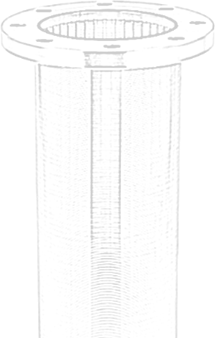
A wedge wire nozzle filter, also known as a Johnson screen nozzle or vee wire filter nozzle, is a stainless steel filtration device commonly installed at the base of pressure vessels, sand filters, activated carbon filters, and ion exchange columns.
Read More
The center pipe/inner screen is the central screening component in radial flow systems which is usually installed in radial flow reactor internals and collects or distributes the flow.
Read More
Our wedge wire basket strainer screen, combined with Wedge Wire profiles, are custom-designed for water/wastewater treatment and liquid filtration.
Read More
Wedge wire is a robust, welded stainless steel structure commonly used for filtration, separation, and media retention. It features surface profiles, typically V-shaped wires, that are resistance-welded onto longitudinal support rods. This precise design ensures accurate slot openings, allowing filtrates to flow efficiently while effectively trapping solids.
Read More
Resin Trap Screen Predominantly Used in Water Treatment Processes Namely In 'ion Exchange' and Other Numerous Media Filter Systems.
Read More
Wedge Wire Trommel screens are extremely efficient in separating soil, compost, waste, aggregates, C&D, wood chips, and other materials.
Read More
The high quality wedge wire baskets are designed for cost-efficiency whilst delivering optimum coal dewatering and separation.
Read More

Yubo Filtration Is A Custom Fabricator And Manufacturer Of Wedge Wire Screen That Applying Strict Quality Practrice.
Optimal Filtration Result Thanks to High-Quality Materials
Over 15 years of solid-liquid separation experience
Expert selection and design of screening components
Supply of high-quality, wear-resistant products
Use of strictly sourced corrosion-resistant steel
Drawing process improves overall performance
Reduce maintenance costs and increase productivity
Do You Want to Improve Your Projects filtation and screening Efficiency?
Get a customized screening solution and custom wedge wire strainers now.
Customize NowWe have an experienced team of designers and engineers, as well as manufacturing capabilities to ensure the best solution in the shortest possible time.


Industrial Water Intake Protection with Johnson Screens
Industrial facilities that draw water from rivers, lakes, seas, or cooling channels face one recurring challenge: debris entering the intake system. Unfiltered intake water can damage pumps, reduce flow efficiency, increase energy consumption, and cause costly downtime.
Nov. 28, 2025